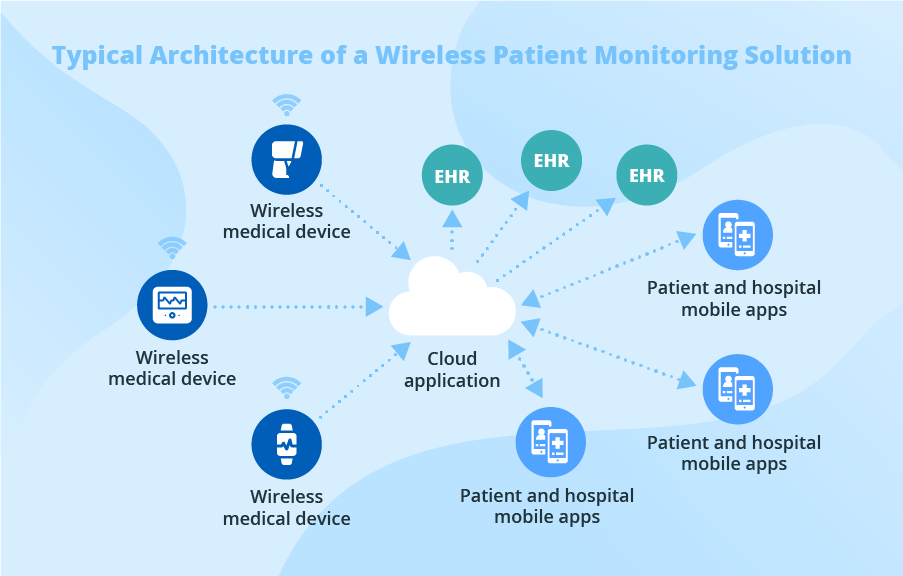An Overview of Wireless Patient Monitoring Solutions in Under 4 Minutes
Editor’s note: Alena explains how a wireless patient monitoring solution works and shows how it can be used in healthcare organizations. If you are interested in using wireless patient monitoring in your organization, you are welcome to leverage ScienceSoft’s experience in developing custom software for medical devices.

The COVID-19 pandemic has fully revealed the importance of providing remote patient monitoring, which my colleague Alena Nikuliak described in her article. Wireless patient monitoring technology offers excellent opportunities for it as this technology allows monitoring a patient’s condition even outside the healthcare organization and avoiding unnecessary visits and physical interactions for the benefit of both patients and medical staff.
Based on ScienceSoft’s experience in developing software for healthcare organizations and medical device manufacturers, I’ll outline the technological aspects of wireless patient monitoring solutions and provide actionable examples of their use.
Typical architecture of a wireless patient monitoring solution

Patient data gathered by wireless medical devices goes to a cloud application where it’s stored and analyzed. Then, the cloud app sends the analyzed data to a healthcare provider’s EHR system, so that medical personnel can use it. Patients and medical staff can also access the data stored in the cloud application via healthcare mobile and web apps.
Trending use cases
From my practice, the common use cases of wireless patient monitoring include:
- Paramedic services. Wireless patient monitoring software solutions are indispensable for monitoring the condition of patients on their way to the hospital.
- Chronic care management. Medical staff can monitor the vitals of chronically ill patients constantly using wireless medical devices and wearable biosensors.
- Smart patient tracking. Wireless patient monitoring solutions can help healthcare providers track patients’ locations with RFID and IoT.
However, the areas of application of wireless patient monitoring do not end with hospital and paramedic care. For example, in one of our projects, we developed a module for wireless monitoring used in software for assisted living facilities. The module allows for continuous monitoring of residents’ health, including vitals, and promptly notifies the personnel about changes in residents’ health conditions. I recommend that you explore our demo of a telehealth app with remote patient monitoring to see how health parameter tracking can streamline patient care.
Data transmission technologies
Before starting a wireless patient monitoring project, you should choose a data transmission technology to allow connectivity between monitoring devices and a cloud application. Below, I’ll briefly describe data transmission technologies that may be used for the proposed architecture.
Wi-Fi. As my practice shows, this technology is one of the most cost-effective, as care providers can use their Wi-Fi (IEEE 802.11) networks to create wireless patient monitoring systems, thus saving their time and money on new network deployment. Moreover, it can be used at patients’ homes for remote patient monitoring as Wi-Fi routers are widespread.
Bluetooth Low Energy. The technology is widely used for wireless patient monitoring as it stands out for its low power consumption, which is a large benefit for wireless medical devices running on batteries. With Bluetooth Low Energy, a mobile application acts as a gateway for a monitoring device or a wearable sensor to a cloud application.
5G standard. It is the newest technology in the wireless data transmitting technology market, so it’s new to the healthcare field as well. The 5G standard allows for quick transferring of large amounts of data, for example, it offers the transmission speed of up to 10 gigabits per second (10 times faster than 4G technology). The main disadvantage of the 5G standard is high power consumption, but it may be considered for applications where high throughput and low latency will be needed.
Time to benefit from your wireless patient monitoring solution
As you can see, wireless patient monitoring technology can enable real-time visibility into patients’ conditions and increase patients’ and medical staff’s mobility in your healthcare organization. However, to ensure these benefits with your solution, you’ll need access to expertise in designing expandable cloud architectures, conducting big data analytics, and more. So, if you feel in need of qualified assistance while developing your wireless patient monitoring solution, my colleagues at ScienceSoft and I will be glad to help.

